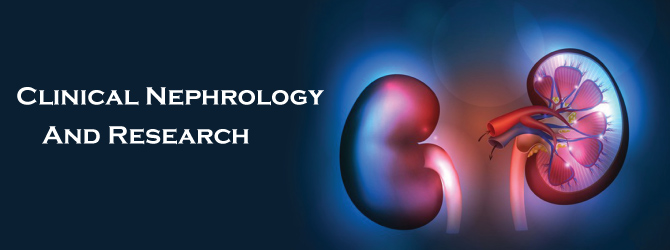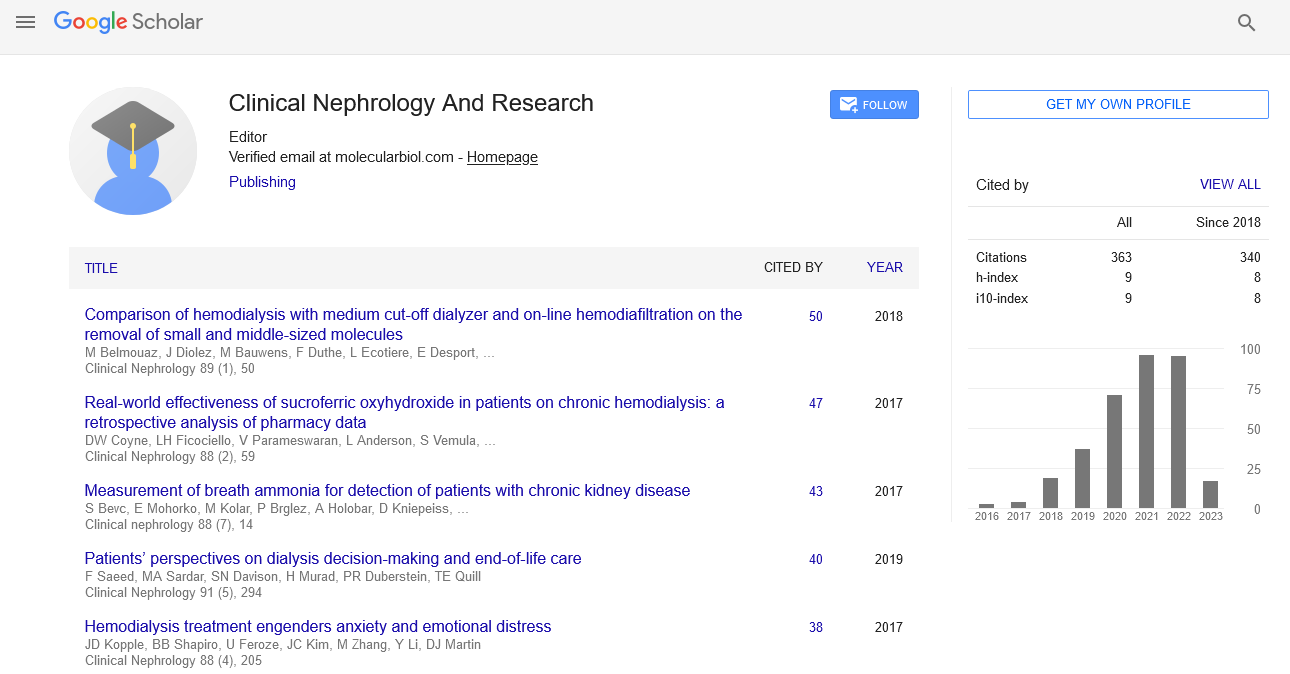Targeting Metabolic Acidosis in Patients with Chronic Kidney Disease (CKD) As a Principle Goal to Decrease Mortality and Slow the Progression of the Disease
Received: 29-Aug-2017 Accepted Date: Aug 30, 2017; Published: 04-Sep-2017
Citation: Taha MM. Targeting Metabolic Acidosis in Patients with Chronic Kidney Disease (CKD) As a Principle Goal to Decrease Mortality and Slow the Progression of the Disease. Clin Nephrol Res. 2017;1(1):1-2.
This open-access article is distributed under the terms of the Creative Commons Attribution Non-Commercial License (CC BY-NC) (http://creativecommons.org/licenses/by-nc/4.0/), which permits reuse, distribution and reproduction of the article, provided that the original work is properly cited and the reuse is restricted to noncommercial purposes. For commercial reuse, contact reprints@pulsus.com
Chronic kidney disease is an independent mortality and cardiovascular disease risk factor, often begins with some kidney damage initially asymptomatic, but as it progresses through the stages of CKD patients develop symptoms and complications of fluid overload, hypertension, hyperkalemia, metabolic acidosis, anemia, and mineral and bone disorders.
Normal kidneys maintain acid-base balance by excretion of the daily acid load by the urinary excretion of hydrogen ions, both as titratable acidity and as ammonium.
Patients with chronic kidney disease live with relatively increased acid load due to reduced nephron mass, but may still be able to maintain near normal acid-base balance especially in the early stages of the disease by increasing ammonium production and excretion in the urine [1].
With progression of the chronic kidney disease (CKD) metabolic acidosis becomes a common complication with increasing prevalence as glomerular filtration rate declines. especially among patients with an estimated glomerular filtration rate (eGFR) < 25 ml/min/1.73 m2 with reported consequences including growth retardation in children, exacerbation of bone disease, increased muscle degradation with resulting frailty, reduced albumin synthesis, and increased inflammation [2]. The prevalence of metabolic acidosis, in non-dialysis dependent chronic kidney disease patients is about 15% [3]. Clinical Practice Guidelines for the Evaluation and Management of Chronic Kidney Disease suggest that in people with CKD and serum bicarbonate concentrations <22 mmol/l treatment with oral bicarbonate supplementation be given to maintain serum bicarbonate within the normal range, unless contraindicated [4,5].
Regarding prevention of chronic kidney disease progression clinical guidelines emphasized glycemic control, individualized blood pressure control, and albuminuria management with ACEI and ARB [4,5].
Early animal studies showed a correlation between metabolic acidosis and the pathogenesis of chronic tubulo-interstitial disease, and also showed the rule of alkali therapy in minimizing this effect. Nath KA, et al, studied supplementation with sodium bicarbonate (NaHCO3) in rats with remnant kidneys, he concluded that alkali supplementation reduced chronic tubulointerstitial disease in the remnant kidney of the rat, and he proposed that this results, at least in part, from reduction in cortical ammonia and its interaction with the alternative complement pathway [6].
Susantitaphong et al, did a systematic review and meta-analysis on 6 randomized controlled trials, on the effect of sodium bicarbonate on benefits and harms in patients with CKD.Their analysis concluded that Alkali therapy was associated with an improvement in kidney function, which may afford a long-term benefit in slowing the progression of CKD. However, they commented that differences in study protocols and small sample sizes preclude definitive conclusions [7].
In regard to the association of metabolic acidosis and all-cause mortality Kovesdy et al. examine the association between baseline and time-variable serum bicarbonate (measured as total CO2) with the outcomes of all-cause mortality and the composite of predialysis.
mortality or end-stage renal disease in 1240 male patients with moderate and advanced non dialysis dependent CKD, and concluded that both lower and higher serum bicarbonates are associated with increased all-cause mortality in patients with moderate and advanced non dialysis dependent CKD patients [8].
Treating metabolic acidosis with sodium bicarbonate is inexpensive, Roderick et al. in a meta-analysis of three trials he examine the benefits and harms of treating metabolic acidosis in patients with CKD, both prior to and after reaching end-stage renal disease. They reported acidosis improved in the intervention group in all three trials , no evidence for an effect on blood pressure or sodium levels. They also reported nutritional status, and protein metabolism were significantly improved [9].
With ongoing research and contribution on this subject Raphael KL et al, evaluated the association between baseline ammonium excretion and clinical outcomes in African American.
Study of Kidney Disease and Hypertension participants, recently published in the Journal of the American Society of Nephrology, they concluded that low ammonium excretion is associated with death and renal failure in hypertensive kidney disease, even among those without acidosis, low ammonium excretion could identify patients with CKD and normal bicarbonate levels who might benefit from alkali before acidosis develops [10].
We as nephrologist may have to pay more attention to metabolic acidosis in CKD patients, and not to ignore borderline serum bicarbonate levels, think in depth about its consequences, the associated decline in renal function, poor outcomes, and the increased mortality.
We may even need to consider monitoring urinary indices for early signs of decreased ammonia production and start early alkali therapy before serum bicarbonate drop below 22 mmol/L, in view of the above recently published study.
REFERENCES
- Garibotto G, Sofia A, Robaudo C, et al. Kidney protein dynamics and ammoniagenesis in humans with chronic metabolic acidosis. J Am Soc Nephrol. 2004;15:1606.
- Kraut JA, Madias NE. Consequences and therapy of the metabolic acidosis of chronic kidney disease. Pediatr Nephrol 2011;26: 19–28.
- Raphael KL, Zhang Y, Ying J, et al. Prevalence of and risk factors for reduced serum bicarbonate in chronic kidney disease. Nephrology (Carlton). 2014;19: 648–54.
- KDOQI US Commentary on the 2012 KDIGO Clinical Practice Guideline for the Evaluation and Management of CKD. Am J Kidney Dis. 2014;63(5):713-35.
- Kidney Disease: Improving Global Outcomes (KDIGO) CKD Work Group. KDIGO 2012 clinical practice guideline for the evaluation and management of chronic kidney disease. Kidney Int Suppl. 2013;3:1-150.
- Nath KA, Hostetter MK, Hostetter TH. Pathophysiology of chronic tubulo-interstitial disease in rats: Interactions of dietary acid load, ammonia, and complement component C3. J Clin Invest 1985;76: 667–75.
- Susantitaphong P, Sewaralthahab K, Balk EM, et al. Short- and Long-Term Effects of Alkali Therapy in Chronic Kidney Disease: A Systematic Review. Am J Nephrol 2012;35:540–47.
- Kovesdy CP, Anderson JE, Kalantar-Zadeh K. Association of serum bicarbonate levels with mortality in patients with non-dialysis-dependent CKD. Nephrol Dial Transplant. 2009;24: 1232–37.
- Paul J Roderick, Narelle S Willis, Sara Blakeley, et al. Correction of chronic metabolic acidosis for chronic kidney disease patients. Cochrane Database Syst Rev. 2007; 1.
- Kalani L. Raphael, David J, et al. Urine Ammonium Predicts Clinical Outcomes in Hypertensive Kidney Disease. J Am Soc Nephrol. 2017;28:2483–90.





